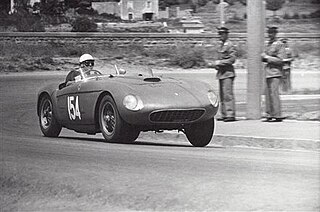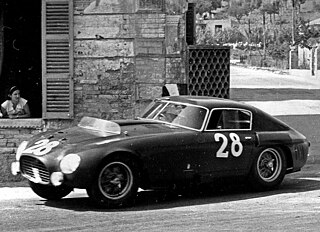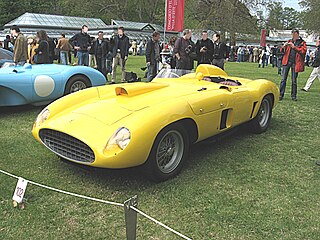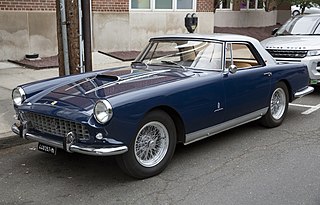
The Ferrari Lampredi engine was a naturally aspirated all aluminum 60° V12 engine produced between 1950 and 1959. Inline-4 and Inline-6 variants for racing were derived from it.

Carrozzeria Scaglietti was an Italian automobile design and coachbuilding company active in the 1950s. It was founded by Sergio Scaglietti in 1951 as an automobile repair concern, but was located across the road from Ferrari in Maranello outside Modena, Italy.

Ferrari America is a series of top-end Ferrari models built in the 1950s and 1960s. They were large grand touring cars with the largest V12 engines and often had custom bodywork. All America models used a live axle in the rear, were front-engined, and had worm and sector steering.

The Ferrari 250 is a series of sports cars and grand tourers built by Ferrari from 1952 to 1964. The company's most successful early line, the 250 series includes many variants designed for road use or sports car racing. 250 series cars are characterized by their use of a 3.0 L (2,953 cc) Colombo V12 engine designed by Gioacchino Colombo. They were replaced by the 275 and 330 series cars.

The Ferrari 212 Inter replaced Ferrari's successful 166 and 195 Inter grand tourers in 1951. Unveiled at the Brussels Motor Show that year, the 212 was an evolution of the 166 — a sports car for the road that could also win international races. In 1951, two 212 Inters, both Vignale coupés, driven by Taruffi/Chinetti and Ascari/Villoresi, scored 1–2 victory at Carrera Panamericana in Mexico.

The Ferrari 340 Mexico was a Ferrari sports racing car which was intended for the 1952 Carrera Panamericana. It used 4.1 L Lampredi V12 engine producing around 280 PS (206 kW) at 6600 rpm, for a maximum speed of 280 km/h. Just 4 were made in 1952, 3 Vignale Berlinettas and 1 Vignale Spyder; all designed by Giovanni Michelotti. Mexico used a 2,600 mm (102.4 in) wheelbase. Chinetti and Lucas finished the race at third place in berlinetta.

The Ferrari 250 S was a sports racing car produced by Ferrari in 1952. It was the first in the long lineage of Ferrari 250 road and race cars powered by a ubiquitous 3.0-litre Colombo V12 engine. In 1952 the 250 S won the Mille Miglia and 12 Hours of Pescara. At the Le Mans, the same year, it clocked the fastest race lap time. Only a single example was produced.

The Ferrari 225 S was a sports racing car produced by Ferrari in 1952. It was an evolution over the preceding Ferrari 212 Export with important engine upgrades that greatly improved power output. The model was extensively used in competition, winning many international races. The most important include 1952 Monaco Grand Prix for sports cars, Portuguese Grand Prix, Coppa d'Oro di Sicilia, Coppa della Toscana, Coppa d'Oro delle Dolomiti and many others. It was the final Colombo V12 engine iteration before the 250-family stretched it to 3.0-litres capacity.

The Ferrari Monza is one of a series of cars built by Ferrari. In the early 1950s, Ferrari shifted from using the compact Gioacchino Colombo-designed V12 engine in its smallest class of sports racers to a line of four-cylinder engines designed by Aurelio Lampredi. Inspired by the success of the light and reliable 2.5 L 553 F1 car, the four-cylinder sports racers competed successfully through the late 1950s, culminating with the famed 500 Mondial and 750 Monza.

The Ferrari 212 Export was a sports racing car produced by Ferrari in 1951–1952. The 212 Exports won Tour de France automobile, Giro di Sicilia, Coppa della Toscana, 10 Hours of Messina and other motor races throughout its career. It was meant to be a sports car available for oversea markets.

Aldo Brovarone was an Italian automobile designer and the chief stylist with Carrozzeria Pininfarina (1974-1988) – widely known for a prominent range of work including the Dino 206 GT, Lancia Gamma Coupé and the Peugeot 504 (sedan).

The Ferrari 250 Monza was a sports racing car produced by Ferrari in 1954. It was a combination of a stretched chassis and body from the line of inline-four-engined racers with an ubiquitous 3.0-litre Colombo V12 engine.

The Ferrari 375 MM, was a sports racing car produced by Ferrari in 1953 up to 1955 for the road cars. It was named "375" for the unitary displacement of one cylinder in the 4.5 L V12 engine, and the "MM" stood for the Mille Miglia race. In total 26 units were made, including four converted from the 340 MM.

Vittorio Jano designed a new 60° V12 engine for sports car racing for Ferrari. This new engine, introduced in 1956, combined elements of both Colombo and Lampredi engines with new features. Engine architecture was more of Lampredi school but retained smaller Colombo internal measurements. Jano moved to Ferrari along with his designs for the Lancia D50 in 1955 and went on to design not only a new V12 but also a family of the Dino V6 engines soon after. Some of the technical ideas came from the Jano's Lancia V8 DOHC engine, intended for Formula One. This family of engines replaced Lampredi inline-4s known from Ferrari Monza line and went on to win many international races and titles for Ferrari. The design team comprised Jano as well as Vittorio Bellentani, Alberto Massimino, and Andrea Fraschetti.

The Ferrari 410 S was a sports racing car produced by Ferrari in 1955–1956. After the racing successes of 375 Plus, mainly in 1954 Carrera Panamericana, Ferrari decided to prepare another model for this marathon. The 410 S was intended as a long-distance race car originally designed for the 1955 Carrera Panamericana and was the final model of the Lampredi V12 sports car lineage. The next generation of sports racing cars that replaced the 410 S were powered by the new Jano V12 engines.

The Ferrari 275 S was a sports racing car produced by Ferrari in 1950. It was the first Ferrari powered by a new Aurelio Lampredi-designed V12 engine, created as a large displacement alternative to the initial 1,5 L Colombo V12, used in supercharged form in Ferrari 125 F1. Formula One regulations allowed for up to 4.5 L in naturally aspirated form.

The Ferrari 250 MM was a sports racing car produced by Ferrari in 1953. After the initial racing successes of the 3.0-litre Colombo V12 engine, introduced in the 250 S one-off, Ferrari produced a serial racing model. It is best recognisable for the distinctive closed berlinetta bodywork by Pinin Farina. The "MM" in its name stood for the Mille Miglia race.

The Ferrari 376 S was a sports racing car produced by Ferrari in 1955. It was the first raced Ferrari powered by a new Aurelio Lampredi-designed inline-6 engine, created as a larger alternative to the inline-4 series of engines used in the Ferrari Monza race cars. The intention behind the development of this model was the 1955 Mille Miglia race. It was yet another attempt by Ferrari to match the new Mercedes-Benz 300 SLR in competition. All of the created cars were further converted into a bigger capacity models.

The Ferrari 250 GT Coupé represented a series of road-going, grand touring cars produced by Ferrari between 1954 and 1960. Presented at the 1954 Paris Motor Show, the 250 Europa GT was the first in the GT-lineage. The design by Pinin Farina was seen as a more civilised version of their sporty Berlinetta 250 MM. Series built cars were an answer to the wealthy clientele demands of a sporty and luxurious Ferrari Gran Turismo, that is also easier to use daily.

Coppa della Toscana was a sports car race held on the roads of Tuscany, through Livorno and Florence, between 1949 and 1954.






















